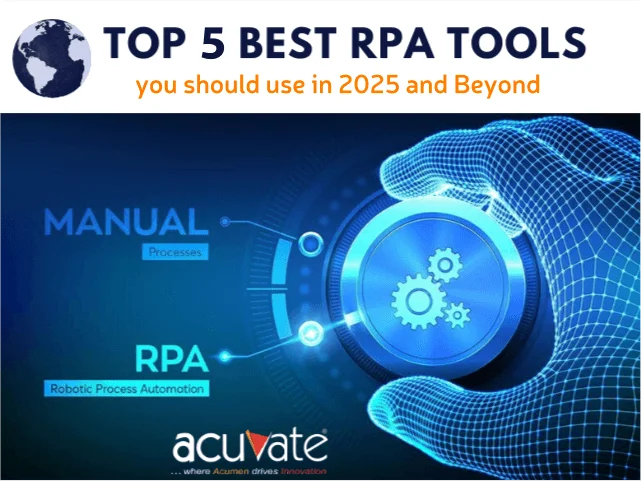Organisations which have successfully deployed one or more pilot RPA projects are struggling to scale up and implement RPA for large scale projects. Although pilot implementations are necessary to test the waters with RPA’s functionality and benefits, they are however limited investments and do not prepare an organisation for a full-scale deployment.
Most organisations kickstart RPA implementation by automating processes that are considered as ‘low-hanging fruits’, typically processes that have a high potential for returns and are less complex in nature. While aiming to automate such processes seems like a feasible strategy, in the long run however, organisations will need to implement RPA on a large-scale as most of these processes will soon be exhausted.
Successfully deploying RPA at a large-scale, needs a less conservative approach and a holistic plan that involves several key elements such as scope of the RPA program, operating model, business plan and change management.
Tips To Scale RPA
1. Process identification and prioritization
This involves assessing processes for their compatibility with automation. Organisations need to devise a methodology by which appropriate processes to be automated can be identified and prioritized based on their potential for automation and complexity that entails for automating these processes.
2. Lay A Robust Foundation
Once you identify the right processes, define and analyze them thoroughly. Consult global process owners (GBOs)on process complexity. Remember, as process complexity increases, so does robot complexity. Secure IT support and buy-in – IT teams usually throw a spanner in RPA implementations. You need to eliminate employee resistance as well – educate them about the project benefits and get their support. Switch from an “experiment” mindset to a “transformation” mindset. Realize the need to invest and partner throughout the project
3. Detailed process assessment and determining the scope of automation
This involves a granular evaluation of the feasibility of automating the processes that have been identified for RPA implementation. Organisations embarking upon robotic process automation will have to distinctly identify the purview of the RPA program. Following are some of the key aspects to be identified for scaling RPA implementations:
- Evaluating the reach of automation among functions of the organisation – whether it extends to all functions or be limited to a few.
- The coverage of automation among entities – limited to a few entities or a global large scale implementation.
- Roadmap and timeline for rolling out RPA among the entities.
- Identifying the multiplicity of RPA initiatives – a single global program or multiple RPA initiatives
4. RPA as a Cloud-based Service
RPA as cloud-based service is an effective strategy to forge large-scale RPA operations. Cloud-based approach provides a single point to access multiple RPA and complementary AI technologies, makes room for additional bots with a single click to address sudden peaks in requirements and enables efficient models on consumption basis.
5. Training RPA developers and analysts on a larger scale
Training and development of RPA developers in the early phases of implementation plays a vital role in RPA expansion programs. Introducing a new technological environment tends to pose a great challenge to the employees to fully understand and lead the initiatives to success. Launching internal training programs to equip employees with the necessary knowledge and skills is imperative to organisations looking to successfully scale RPA operations.
Total automation is not only limited to Centres of Excellence, it rather is a concerted effort by both CoE and skilled employees among various departments across the organisation. The trained citizen developers have an important role in hastening the process of RPA expansion and bringing down the cost of development and implementation.
6. Establishing Agility in Change
Having a digital workforce that is fast, scalable and available round the clock provides a competitive advantage while scaling RPA. Building a responsive support for RPA with ownership from several teams across the enterprise establishes a robust mechanism for scaling the technology. Adopting agile ways of working enables the organisation to fully leverage robotic and cognitive automation.
7. Set High Targets and define metrics
Aim high and establish significant targets. For instance, instead of aiming for reducing headcount, aim for the top line, quality and compliance. Decide on the metrics necessary to measure the effectiveness of RPA.
8. Devising An Effective Operating Model
When scaling RPA operations IT department should manage the configuration, software distribution, and robot scripts whether it’s managed from an individual agent’s computer or centralized production environment.
Having support staff, necessary technical resources, maintaining security access and records of incidents is an essential part of operating strategy to scaling operations. While it is time consuming to successfully scale RPA operations, devising a comprehensive operating strategy can help the IT department hasten the implementation of the project.
9. Stakeholder and Change Management
Stakeholders incharge of implementing RPA need to educate the top management about RPA and guide IT, security department and business line managers to collaborate synergistically towards the success of RPA implementation.
During the implementation of the automation program, organisations will have to develop strategies for change and communication management to address the concerns of people who will be directly affected by the implementation of the technology.
10. Aim For Total Automation
Bringing about a full scale automation, contrary to the popular strategic belief, is necessary to realise the full potential of automation. Automating processes that are low in complexity and investment do not bring about the critical rate of changes necessary for expanding RPA operations and often do not meet the ROI of RPA initiative.
The ‘total automation’ approach despite involving large investments is key to realize a significant improvement in performance and productivity across the organisation. This cannot be achieved with a low-risk low-return strategy of implementing RPA on siloed processes. The full impact of automation is accomplished by implementing RPA across an entire department which yields a much larger ROI on a longer timeframe.
Conclusion
Robotic Process Automation has far reaching benefits and tapping into its full potential requires an enterprise-wide implementation than experimenting with pilot initiatives.
Scaling RPA operations needs a comprehensive assessment and identification of processes that are appropriate for automation and determination of the scope of the technology. Employees are an indispensable part of the expansion program and ensuring them with effective training is essential to RPA’s success.
While organisations go through transformation, it is necessary for the leaders to manage the changes, handle collaborations and communicate with the employees to assuage them of any apprehension due to the eminent changes.
If you’re planning to implement RPA in your organization, please feel free to get in touch with one of our RPA experts for a personalized consultation. You may also be interested in checking out our RPA implementation services and solutions.
Further Insights:
- Top RPA Use Cases In Different Industries
- Top 9 Best RPA Tools You Should Use In 2020 And Beyond
- How Does RPA Look In Action- Manufacturing, Pharma And Retail
If you’d like to learn more about this topic, please feel free to get in touch with one of our AI and digital workplace consultants for a personalized consultation.



